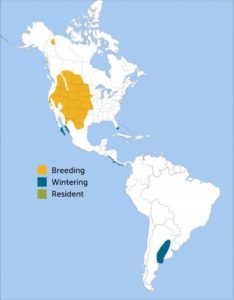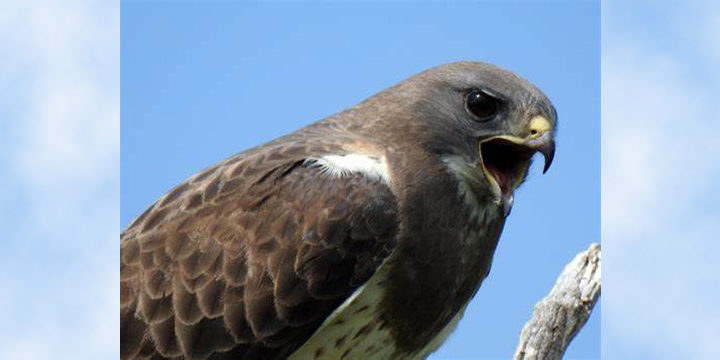Bird of The Week: Swainson’s Hawk
Scientific Name: Buteo swainsoni
Population: 900,000
Trend: Stable
Habitat: Breeds in open grasslands, shrubby areas, and farm fields; mostly winters on pampas grasslands and farm fields.
About the Swainson’s Hawk
From late spring through summer, this handsome western buteo is a familiar sight over open country in many parts of the West, soaring overhead on long, bicolored wings. But in fall, this raptor leaves breeding grounds and migrates long distances, like the Broad-winged Hawk, though heading even farther south.
Sleeker and more acrobatic than the familiar Red-tailed Hawk, the Swainson’s also seasonally changes its diet in much more dramatic fashion than does its heavier cousin.
Grasshopper Hawks
Some of the Swainson’s Hawk’s nicknames include “grasshopper hawk” and “locust hawk,” and for good reason. Invertebrates are a big focus for this grassland species, and the timing of this bird’s migration to the Southern Hemisphere matches ideal prey abundance there. The birds’ pampas wintering grounds are really “summering” grounds, bathed in heat and thronging with insects by the time the birds arrive. Insects, in the air and on the ground, feature heavily in the diet of migrating Swainson’s Hawks as well. Once back on northern nesting grounds, though, these birds do a change-up, mainly targeting vertebrates while feeding their nestlings.
Songs and Sounds
The most commonly heard Swainson’s Hawk vocalization is a protracted shrill shriek, somewhat like that of the Red-tailed Hawk, but not nearly as halting.
.
Breeding and Feeding
Messy Nest
Swainson’s Hawks often nest in scattered trees or shrubs, and sometimes on power poles and cliffs, in open areas including grasslands and agricultural landscapes. They sometimes reuse old nests, including those of American Crows, Common Ravens, or magpies.
The male selects the site, then the pair spends a week or two constructing an untidy jumble of sticks, sometimes incorporating bits of rope or wire, or plants such as tumbleweeds (Russian Thistle). The pair lines the nest with softer materials, including small twigs with leaves still attached, grasses, hay, and forbs. There, the female lays one to four eggs, which she incubates for just over a month, briefly spelled from time to time by her mate. Once nestlings hatch, they remain in the nest for about a month and a half, until they can fly.
Initially, the male brings most of the food to the nest. There, it is torn up and given in small chunks to both the female and young. As nestlings grow larger, the female resumes hunting.
Versatile Hunter
Swainson’s Hawks eat insects much of the year, but switch their menu mostly to vertebrates during breeding season. Then, depending upon location and local availability, these birds hunt small mammals including ground squirrels, pocket gophers, voles, mice, and rabbits; smaller birds as large as the Burrowing Owl; and snakes and lizards.
For buteos, Swainson’s Hawks are long-winged and sleek, built for nimble maneuvering both in the sky and on land. They capture dragonflies and grasshoppers on the wing, sometimes scamper after insects on the ground, and often swoop down on prey from a perch or in a stoop after soaring or cruising overhead. Outside the nesting season, Swainson’s Hawks consume large quantities of grasshoppers, crickets, beetles, dragonflies, and other insects; they sometimes even follow farm vehicles to gather flushed or crushed insects.
Region and Range
Massive Migrations

Swainson’s Hawk range map by ABC
The Swainson’s Hawk breeds in open country across western North America. Starting in late August and September, nearly its entire population begins to head south toward wintering areas in in southern Brazil and Argentina. At concentration points, the birds gather in huge “kettles” or flocks, which can be immense. A large portion of the hawk’s entire population can pass by single hawk-watching sites in Veracruz, Mexico, in a single season. Most pass over Central America from October to early November, then return, headed north, March to May.
Typically, the migration is a round trip of more than 12,000 miles – among the longest of any North American raptor. Some Swainson’s Hawks, though, don’t go this far: Small numbers occur in winter along the Pacific Coast from Mexico to Panama, and Swainson’s Hawks are rare in winter in South Florida, South Texas, and California.
Conservation
A Perilous Pesticide
In the 1990s, Swainson’s Hawks showed an alarming decline in the western U.S., which was traced to heavy mortality on their wintering grounds. It is estimated that more than 20,000 birds died in one season alone, carpeting the ground in some places. This disastrous die-off turned out to be due to the toxic pesticide monocrotophos, which was used to control insects in sunflower fields. The hawks had been eating poisoned grasshoppers and dying in huge numbers. Although this pesticide was removed from use in the U.S. in 1991, it was still being widely used in Latin America.
In 1996, ABC spearheaded an international campaign to remove monocrotophos from Swainson’s Hawk wintering habitat, and to educate Argentinean farmers on safer pest control techniques. ABC successfully urged Ciba-Geigy (now Novartis) to halt distribution of monocrotophos to Argentina, and persuaded the Argentinean government to stop all uses, a major international conservation victory.
Since then, Swainson’s Hawk numbers have stabilized – an encouraging sign for this Neotropical migrant, although habitat loss remains a challenge for this and many other species.
Get Involved
Policies enacted by the U.S. Congress and federal agencies, such as the U.S. Fish and Wildlife Service, have a huge impact on migratory birds. You can help shape these rules for the better by telling lawmakers to prioritize birds, bird habitat, and bird-friendly measures. To get started, visit ABC’s Action Center.
Living a bird-friendly life can have an immediate impact on migratory birds in the United States. Doing so can be as easy as adding native plants to your garden, avoiding pesticides, and keeping cats indoors. To learn more, visit our Bird-Friendly Life page.
American Bird Conservancy and our Migratory Bird Joint Venture partners have improved conservation management on more than 8.5 million acres of U.S. bird habitat — an area larger than the state of Maryland — over the last ten years. That’s not all: With the help of international partners, we’ve established a network of more than 100 areas of priority bird habitat across the Americas, helping to ensure that birds’ needs are met during all stages of their lifecycles. These are monumental undertakings, requiring the support of many, and you can help by making a gift today.
Source: American Bird Conservancy (abcbirds.org)


